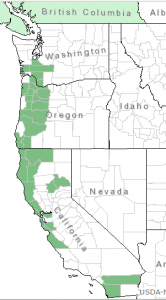Western Burning Bush Celastraceae–The Spindle Tree Family
Euonymus occidentalis Nutt. ex Torr.
(yew-ON-ih-mus ok-sih-den-TAY-lis)
Names: Western Burning Bush is also known as Western Wahoo, Western Strawberry Bush or Pawnbroker Bush. Occidentalis means western. Burning Bush refers to the fall foliage color; Strawberry Bush alludes to its colorful fleshy seeds. Plants in this genus are generally called Spindle Trees because the wood of some species was traditionally used to make spindles for spinning wool.
Relationships: There are about 175 species of euonymus, or Spindle Trees; mostly native to Asia, they are also found in Europe, Australasia, Madagascar, and North America. Only four are native to North America, but many ornamental species have been introduced and have naturalized in the east, such as Burning Bush, E. alatus, and European Spindle Tree, E. europaeus.

Distribution of Western Burning Bush from USDA Plants Database
Distribution: Western Burning Bush is the only native euonymus on the west coast. It is found west of the Cascade Mountains from Thurston County in southwest Washington to southern California. In British Columbia, it is only known to occur on Vancouver Island. It is listed as sensitive in Washington State.
Growth: This species is a straggly shrub growing 6-15 feet (2-5m) tall.
Habitat: It is mostly found in moist woods; sometimes in grassy areas with a few trees.
Diagnostic Characters: Opposite leaves are oval-shaped, finely toothed with a pointed tip. Small, greenish or purplish-mottled to bronzy, dark purplish-red flowers are borne in clusters of three in the leaf axils. Fruit is a 3-lobed capsule, which opens to expose seeds that are covered by a reddish-orange, fleshy aril. Non-hairy branches have narrow, parallel, longitudinal lines or grooves.
In the Landscape: Hitchcock writes that Western Burning Bush “is probably classed as a botanical collector’s item rather than a plant of much horticultural merit.” This spindly shrub may, however, be useful in a shady corner of the garden. It has a nice yellow to orange-red fall color–although not as brilliant as the cultivated Burning Bush, E. alatus, it is bright enough in stand out in the shade. The fleshy orange-red arils are an interesting feature of this plant.
Phenology: Bloom time: May-June; Fruit ripens: September-November.
Propagation: No information is available for the species, but seeds of plants in the genus Euonymus generally require 3-4 months stratification at 32-50º F (0-10º C). Euonymous is easily propagated from cuttings (hardwood cuttings in early spring) or from layering.
Use by People:
Use by Wildlife: Birds digest the fleshy seed coat and disperse the seeds in their droppings. Flowers are pollinated by insects. The ASPCA lists this plant as toxic to horses, cats and dogs.
Links:
Consortium of Pacific Northwest Herbaria
WTU Herbarium Image Collection, Plants of Washington, Burke Museum
E-Flora BC, Electronic Atlas of the Flora of British Columbia
